How to Trim Apple Trees for Better Growth and Fruit Yield
Pruning apple trees is a vital practice for any gardener or orchardist aiming to grow healthy, productive trees that yield high-quality fruit. Whether you are growing dessert apples for snacking, cooking apples for baking, cider apples for brewing, heirloom varieties for their rich history, or even crab apples for jelly or ornamental purposes, proper pruning makes all the difference.
Over the years, I have pruned hundreds of trees around Fremont, from backyard growers to large landscapes. If you are a home gardener, DIY hobbyist, or homeowner, and you want to keep your apple trees in great shape, this guide is for you. Even if you are new to pruning or unsure where to begin, do not worry. I will walk you through every key step.
If you are trimming fruit trees other than apples, I recommend reviewing our general fruit tree pruning guide, which covers various tree types and shapes.
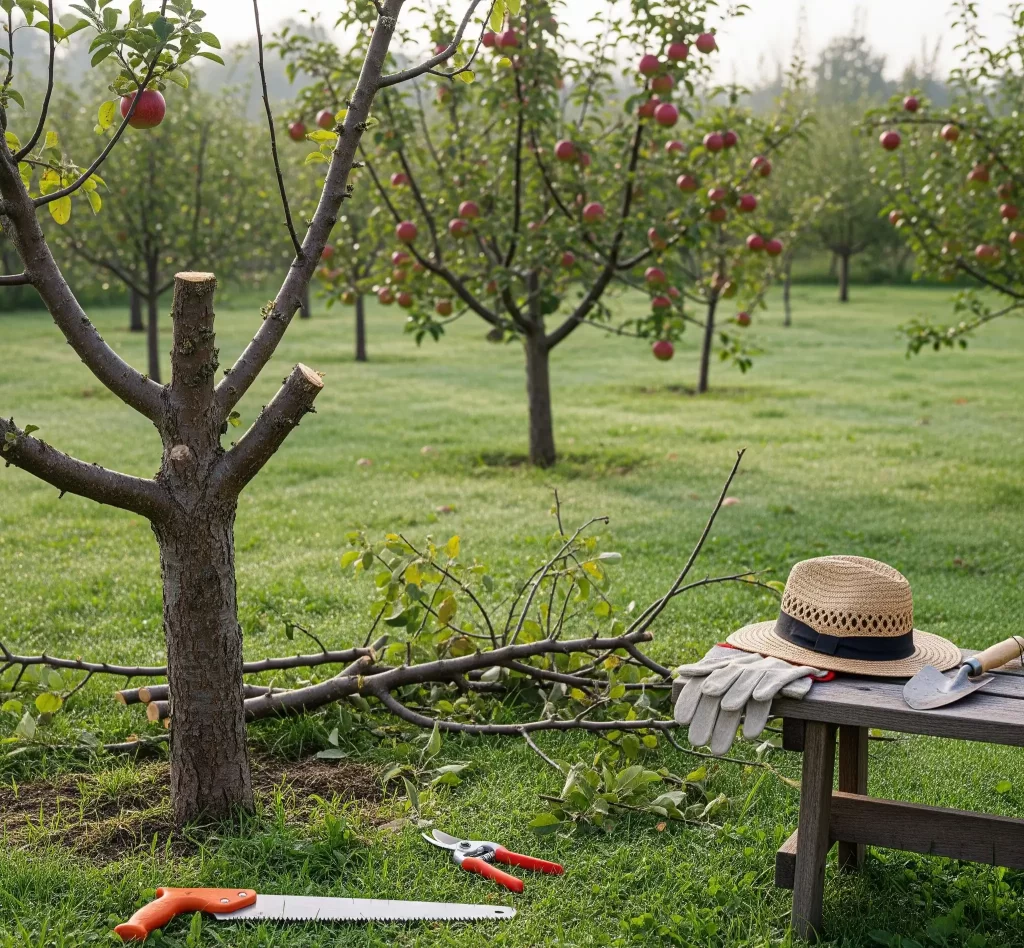
Get the most out of your apple trees with smart, seasonal pruning techniques designed for home gardeners and small orchards.
Understanding Apple Tree Types
While apple trees are often categorized by their intended use, such as for eating, cooking, or cider, pruning methods depend more on their fruiting habit: whether they are spur-bearing or tip-bearing.
Recognizing this distinction helps you avoid one of the most common pruning mistakes: accidentally cutting off next year’s fruiting wood.
How does apple pruning fit into the broader tree care process? Read our full guide on how to trim trees for a bigger-picture view.
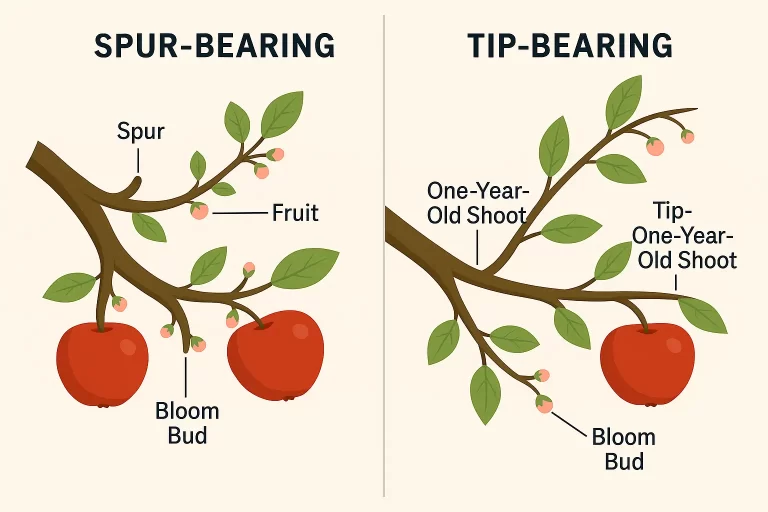
Why You Should Prune Apple Trees
Pruning supports tree health, improves fruit production, and helps maintain structure. For me, it’s about balance, removing what’s not helping the tree, and encouraging what is. You want strong growth, good light penetration, and accessible fruit.
If you are wondering about timing, you will get the best results pruning in late winter or early spring, when the tree is dormant. That’s covered in detail in our seasonal timing guide, which shows why pruning too early or too late can stress the tree.
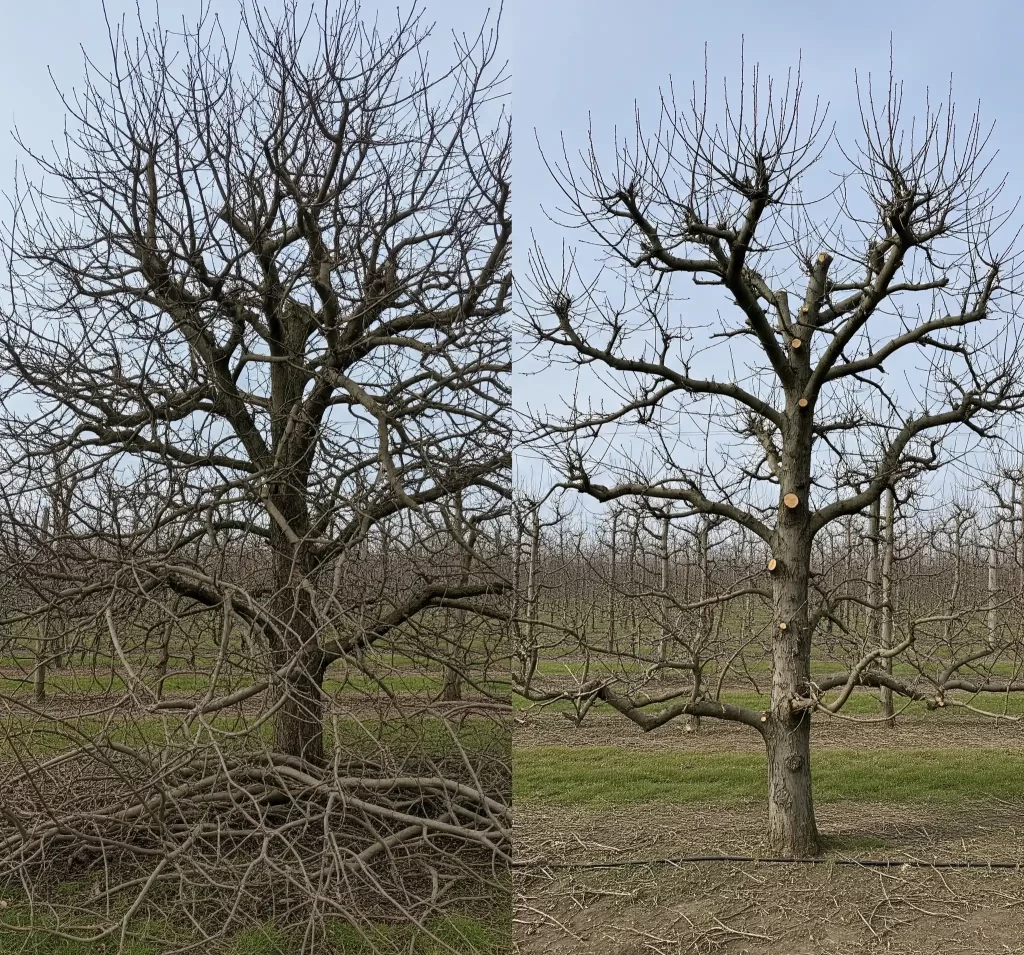
Before Pruning After Pruning
Before Pruning After Pruning
Tools You Will Need to Prune Apple Trees
Over time, I have tested a lot of gear. I can tell you that the tools you use matter as much as the technique. Dull blades, wrong-size tools, or unsafe gear can ruin a clean cut, or worse, injure you.
I have put together a dedicated tree trimming tools guide covering everything I use on jobs, from shears to saws, plus safety gear, and usage tips. But here’s a quick overview for this post:
- Hand Pruners – Best for small branches (under ½ inch). I carry mine on every job.
- Loppers – Needed when you are dealing with medium-sized branches (½–1½ inches).
- Pruning Saw – When you have thicker limbs to cut.
- Tripod Ladder – Safer for tall trees than leaning ladders.
- Protective Gear – Gloves, a helmet, and safety glasses are a must, even if you are trimming a small tree.
The right tool doesn’t just help with clean cuts; it protects the tree from ragged edges, which can attract pests and disease. If your last trim left rough wounds or splinters, the tool might’ve been the problem, not you.
Pruning Techniques That Work for All Apple Trees
I always start by walking around the tree. Get to know it. Look at its shape, where the sun hits, and where the branches cross or shade each other. Whether your tree is young, overgrown, or mature, this is where good pruning starts.
Here’s how I typically work:
1. Remove dead, damaged, or diseased wood
These are easy to spot—branches that are dry, brittle, have no buds, or are dark and shriveled. Removing them not only improves the tree’s health but also prevents pests from establishing a foothold.
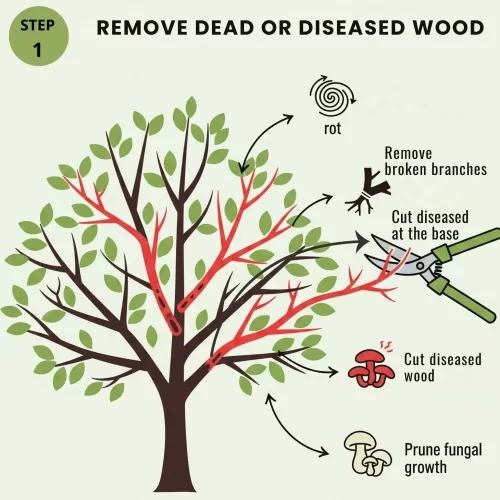
2. Thin overcrowded areas
Branches rubbing together or growing inward toward the trunk need to be removed. I focus on opening up the canopy, which helps sunlight reach the center and improves air circulation. This is especially important for apple varieties prone to fungal diseases.
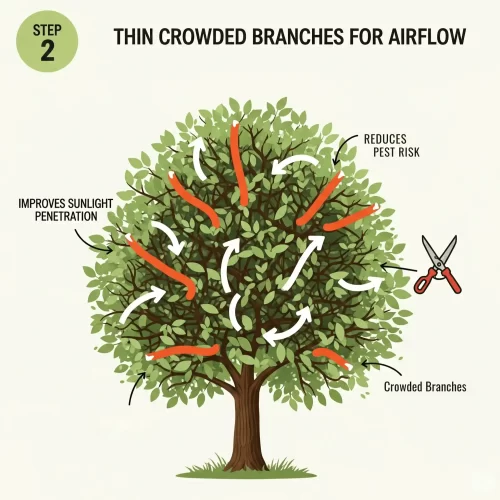
3. Maintain structure with proper shaping
For young trees, I often use a central leader system—a strong main trunk with evenly spaced horizontal branches. For older or mature trees, I opt for an open-center or vase-like structure to allow for more light and airflow. I have used both styles across different apple types, depending on how the tree has developed.
If your tree is getting too tall to manage, don’t cut the top off. That causes more harm than good. Instead, each winter I reduce height gradually by trimming back to a strong lateral branch, the kind of technique we also use on larger trees during professional pruning jobs.
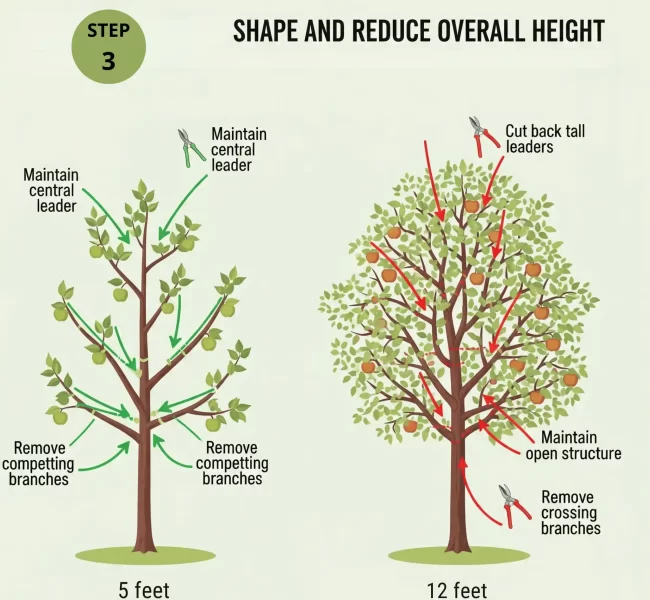
Spur-Bearing vs. Tip-Bearing Pruning Adjustments
Spur-Bearing Trees
Examples: Honeycrisp and Fuji
Spur-bearing trees produce fruit on short, woody spurs along older branches. When pruning these, I:
- Thin out the spurs to 4–6 inches apart
- Shorten old spurs to encourage new ones
- Open up the tree for better light—critical for sweeter, high-quality fruit
Tip-Bearing Trees
Examples: Bramley and Granny Smith
Tip-bearing trees grow fruit at the ends of one-year-old shoots. With these, I’m more careful:
- Avoid cutting back branch tips unless they’re diseased
- Thin interior growth only
- Limit overall pruning to avoid losing too many fruiting sites
Not sure which type you have? Watch your tree during bloom season. If most buds are near the shoot tips, it’s likely tip-bearing.
Adjusting for Tree Age and Condition
Young Trees (1–5 years old)
After planting a whip (a single-stem tree), I usually cut it back to about 30 inches high. This encourages branching. Over the next few years, I will train 3–4 strong scaffold branches spaced evenly around the trunk. The idea is to build a solid, balanced framework early on.
Mature Trees
For trees that are already producing well, I stick to light structural pruning every couple of years. I’ll thin 10–20% of the canopy, remove water sprouts, and clean up damaged limbs. With spur-bearing types, I’ll also reduce the number of fruiting spurs so the remaining apples grow larger.
Overgrown or Neglected Trees
If I find myself facing a big old apple tree that hasn’t been touched in years, I take it slow. The first year, I remove dead wood and maybe reduce the canopy height by 20–25%. In year two or three, I focus on reshaping and thinning out dense areas. Pruning too much at once can shock the tree or lead to weak regrowth.
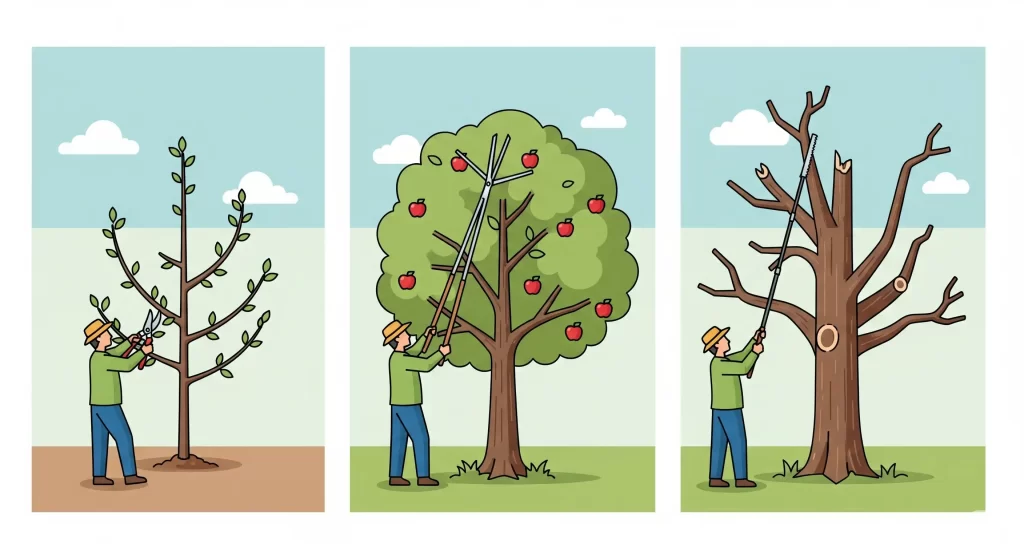
Espaliered Apple Trees
If you are short on space but still want a productive apple tree, espalier training offers a practical and decorative solution, especially for spur-bearing varieties. Espalier training involves growing trees flat against a wall or fence, making it ideal for small spaces. I have mostly used this method with spur-bearing types like Gala or Fuji.
During winter, I train new horizontal branches and prune vertical growth.
In summer, I shorten the side shoots to 3 to 4 buds to encourage the formation of fruiting spurs.
Tip-bearing varieties do not respond well to espalier training. You will likely cut off next year’s fruit if you are not careful, so I avoid using them for this technique.
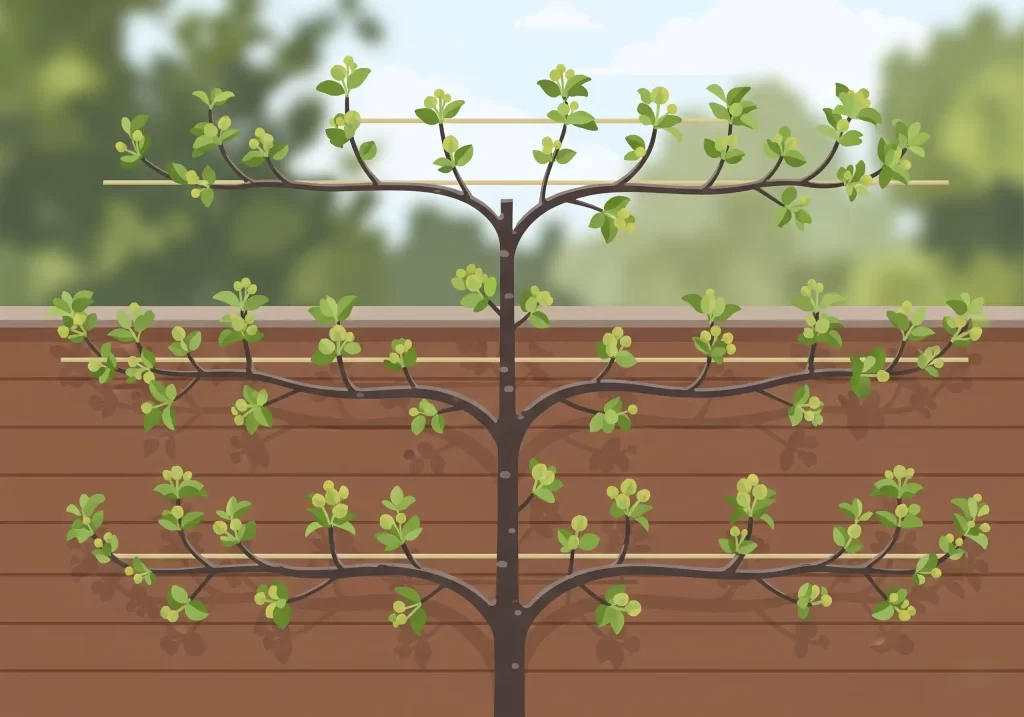
Let’s Shape a Healthier Apple Tree Together
After working with countless apple trees, here’s what I can tell you: pruning doesn’t need to be perfect, just intentional. Focus on removing what’s weak or crowding the canopy, and give your tree the space it needs to grow strong and produce more.
A few practical tips to keep in mind:
- Step back often and study the shape as you go.
- Keep tools sharp for clean cuts and quick healing.
- Spread heavy pruning over multiple seasons if needed, especially on older trees.
- If you are not sure about cutting a branch, observe it over time. Trees will tell you what they need if you’re paying attention.
Not sure where to start or nervous about making the wrong cut?
I offer free pruning estimates and honest advice based on your tree’s condition and location.
Tap the button below, and I will help you figure out the right next step for your apple tree.